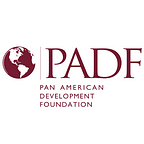By Felipe Jacome
“This water system is the community’s most precious jewel,” Jean Jaquet tells me proudly.
We stand in front of a concrete pyramid-shaped structure at the top of La Montagne’s drinking-water system that the Pan American Development Foundation (PADF) built, eight miles up a bumpy road from the town of Jacmel in southeastern Haiti. A few feet away, in the shade of the Caribbean foliage, a dozen people fill up their buckets and gallon jugs from a public water tap.
“This is the catchment basin for the drinking water system that PADF built two years ago. Since then, the community has taken over the management of the system, providing drinking water to the people living in La Montagne,” he explains.
At our feet, a series of PVC pipes stem down the hill bringing water through two chlorine treatment reservoirs to six taps providing clean drinking water for over 6,500 people.
Jacquet, 36, the director of a local school, is right to be proud of the community managed potable water system. In La Montagne and five other localities where the project was implemented with funding from the OPEC Fund for International Development (OFID), PADF and the national water and sanitation agency, DINEPA, included the beneficiary communities every step of the way, from the planning stages, through the handover of the systems to local water management committees known as CAEPAs.
A member of a local CAEPA, Jacquet is adamant about the involvement of the community in the sustainability of the project.
“The committee is constantly meeting with the community to raise awareness of the fact that everybody needs to do their part in taking care of the system and avoiding contamination of the water. We know from experience that if the community doesn’t take care of it, then it will fall apart,” he says.
At the public tap, Rosemy Blan, 22, fills up her bucket before hiking 30 minutes up the mountain to her house. When asked about how she can protect the water system she promptly cites ‘not letting our animals drink or defecate around the taps’ and ‘contacting the CAEPA if you see a broken pipe.’
According to Frantz Pierre Louis, DINEPA’s representative in the Southeast Department, water management committees such as the one in La Montagne are “a crucial component in the sustainability of water provision systems in rural and peri-urban areas” and a “pillar of DINEPA’s national water provision strategy.”
The small town of Sable Cabaret, at the bottom of La Montagne, is the last place served by the water system. Here, taking advantage of the proximity of the houses to the water lines, a dozen households have started to pay CAEPA a small fee of 100 Gourds (2.50 USD) for a private water tap in their house. The CAEPA in turn uses the fees to pay for any repairs in the system.
But perhaps the greatest pride for La Montagne is that the water system has almost entirely spared them from the cholera epidemic that has killed thousands in the past two years.
“We have seen only a handful of cases of cholera around here,” says Fania Saint Vil, 32, while filling up a gallon jug. “Several communities close-by have seen many deaths from cholera. We are extremely fortunate to have clean drinking water,”
As we leave La Montagne, I’m caught by the site of inhabitants of the neighboring community Cité Lumière fetching water in a stream. “That’s how people of La Montagne got their drinking water before the system was built,” Jacquet tells me while pointing at the stream. “And that’s why everyone in the community does their part in protecting the water system.”
